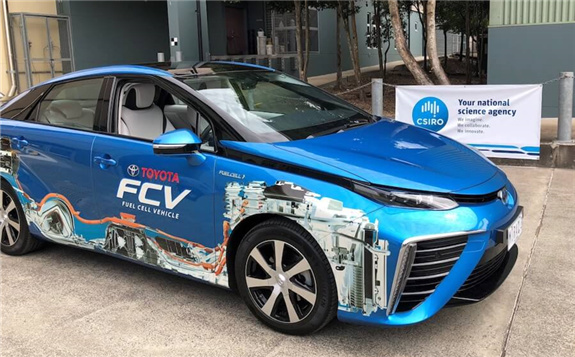The transformation of part of Toyota’s decommissioned car manufacturing plant in Altona Victoria into a renewable energy hub to produce green hydrogen for transport is well underway. On Wednesday, the carmaker unveiled the first stage of its $7.4 Hydrogen Centre marking the 50th anniversary of Earth Day.

This first stage of the project, which is being developed with $3.1 million of funding support from the Australian Renewable Energy Agency (ARENA), comprises an education facility designed to demonstrate how hydrogen can play a significant role in both the future of transport and the broader energy economy. While the current Covid-19 restrictions mean the education center is unable to welcome visitors, its completion marks an important step towards a larger transformation planned for the former car manufacturing site, which was closed in 2017.
In addition to the education center, the Hydrogen Centre will include solar PV and battery storage to cover the incremental energy requirements for the production of renewable hydrogen through electrolysis and utilization for both mobile and stationary applications. It will also include Victoria’s first commercial-scale hydrogen vehicle refueling station infrastructure on-site to allow the refueling of hydrogen fuel cell vehicles. The permanent sustainable hydrogen production and storage facility and the commercial-grade refueling station are due to be completed by the end of the year.
Once operational, the project will produce at least 60 kg of hydrogen per day. As it seeks to demonstrate hydrogen as a viable fuel source for transport and as an energy storage medium, Toyota’s Hydrogen Centre will also be an important step towards the company meeting its target of zero emissions from sites and vehicles by 2050. As a step in between, the carmaker aims to reduce the global environmental footprint of its new vehicles and manufacturing plants and facilities by 35% by 2030 compared to 2013 levels.
Toyota Australia Manager Future Technologies and Mobility Matt MacLeod said locally, the company’s investment in the hydrogen economy, the increased availability and demand for its hybrid vehicles, and its growing solar capacity at its Australian facilities are providing a significant contribution to meeting the global CO2 reduction targets.
“Currently, cars and light commercial vehicles contribute about 11 per cent of Australia’s transport CO2 emissions. The Toyota Mirai FCEV (Fuel Cell Electric Vehicle) that has been trialed for the past year by a number of organisations including local councils in Melbourne produces zero harmful emissions – nothing but water vapour,” he said. While Toyota is committed to developing hydrogen FCEVs, the growing demand and availability of hybrid petrol-electric vehicles are also helping to reduce GHG emissions with more than 130,000 vehicles delivered to Australian drivers since 2001.
Solar-powered facilities
Toyota is also actively seeking to slash emissions from its facilities in Australia with the help of on-site renewable energy generation. Over the past two years, the company has expanded its solar fleet to 1,156kW of cumulative capacity across three key properties in Sydney, Altona, and Brisbane.
The largest system is installed on the Toyota Parts Centre in western Sydney featuring a 605kW solar array made up of 2,200 panels. The PV array is capable of generating 874MWh per annum which, according to Toyota Australia, will help deliver on the target for the center to be a zero CO2 emission facility by the end of this year.
An additional 87kW solar system will soon be commissioned at the Altona site linked to the Hydrogen Centre redevelopment.